Table of Contents
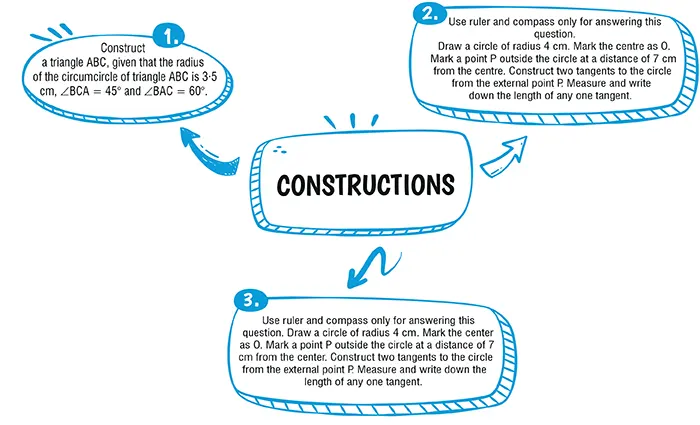
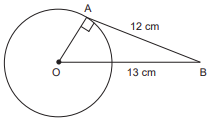
Ans. (b) 5 cm
Explanation:
△AOB is a right angle triangle.
∴ by pythagoras theorem
(OA)^2 = (OB)^2 - (AB)^2\\
OA = (13)^2 - (12)^2
OA = 169 - 144 = 25
= 5 cm.
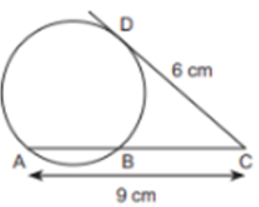
Ans. (b) 5 cm
Explanation:
As we know that
(DC)^2 = AC × BC \\
(6)^2 = 9 × BC
BC = 369 = 4 cm.
Now AB = AC – BC
= 9 – 4
AB = 5 cm
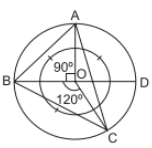
Explanation:
Steps of construction :
(i) Draw a circle with radius = 3·5 cm.
(ii) Draw diameter BOD and construct ∠BOA = 90°.
(iii) Again make ∠BOC = 120°.
(iv) Join AB, AC and BC. Then, ABC is the required triangle
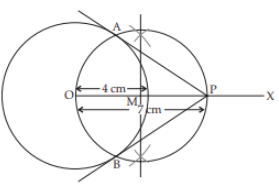
Explanation:
Given, radius = 4 cm and OP = 7 cm
Steps of constructions :
(i) Draw a circle of radius 4 cm with centre at O.
(ii) Draw a line OX and cut-off OP = 7 cm.
(iii) Bisect OP at M.
(iv) With M as centre, draw a circle passing through the points O and P to cut the previous circle at A and B.
(v) Join P with A and B. Hence, AP and BP are the required tangents.
∴ The length of tangent, AP = 5.7 cm
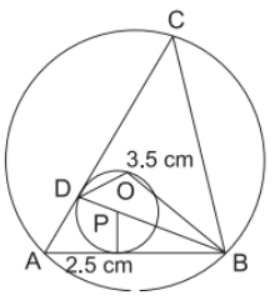
Explanation:
Steps of construction :
(i) Draw a line segment AB = 5 cm long.
(ii) Make an angle of 75° at ‘B’ draw perpen -dicular bisector of AB and angular bisector of B.
(iii) Mark 3·5 cm on the perpendicular bisector with O as center and radius equal to OA or OB draw circumcircle.
(iv) Mark 2·5 cm on AC from A.
(v) Join BD, it will intersect at P, with P as centre and PD as radius draw another circle.
Download Mind Map of this chapter
Download NowWant to Practice Mock Tests of this chapter
Practice NowDownload Important Questions of this chapter
Download Now| Chapter No. | Chapter Name |
|---|---|
| Chapter 1 | Goods and Service Tax (GST) |
| Chapter 2 | Banking |
| Chapter 3 | Shares and Dividends |
| Chapter 4 | Linear inequations |
| Chapter 5 | Quadratic Equations in one variable |
| Chapter 6 | Ratio and proportion |
| Chapter 7 | Factorization |
| Chapter 8 | Matrices |
| Chapter 9 | Arithmetic Progression |
| Chapter 10 | Geometric Progression |
| Chapter 11 | Coordinate Geometry |
| Chapter 12 | Reflection |
| Chapter 13 | Similarity |
| Chapter 14 | Loci |
| Chapter 15 | Circles |
| Chapter 16 | Constructions |
| Chapter 17 | Mensuration |
| Chapter 18 | Trigonometry |
| Chapter 19 | Statistics |
| Chapter 20 | Probability |
Ans: Constructions in mathematics are methods for creating geometric figures using only a compass and a straightedge, without using measurements or numerical values.
Ans: Constructions help students understand geometric concepts, develop problem-solving skills, and have real-world applications in fields like engineering and architecture.
Ans: The primary tools used in constructions are a compass (for drawing circles and arcs) and a straightedge (a ruler without markings).
Ans: Bisecting an angle means dividing it into two equal parts. This skill is used in various geometric constructions and to create angles of specific measurements.
Ans: To draw a perpendicular bisector, use a compass to create arcs on both sides of the line segment. Then, draw two arcs of equal radius above and below the segment. The intersection points are the endpoints of the perpendicular bisector.
| Chapter Wise Important Questions for ICSE Board Class 10 Mathematics |
|---|
| Goods and Service Tax (GST) |
| Banking |
| Shares and Dividends |
| Linear inequations |
| Quadratic Equations in one variable |
| Ratio and proportion |
| Factorization |
| Matrices |
| Arithmetic Progression |
| Geometric Progression |
| Coordinate Geometry |
| Reflection |
| Similarity |
| Loci |
| Circles |
| Constructions |
| Mensuration |
| Trigonometry |
| Statistics |
| Probability |
CBSE Important Questions Class 10
ICSE Important Questions Class 10
CBSE Important Questions Class 10
ICSE Important Questions Class 10